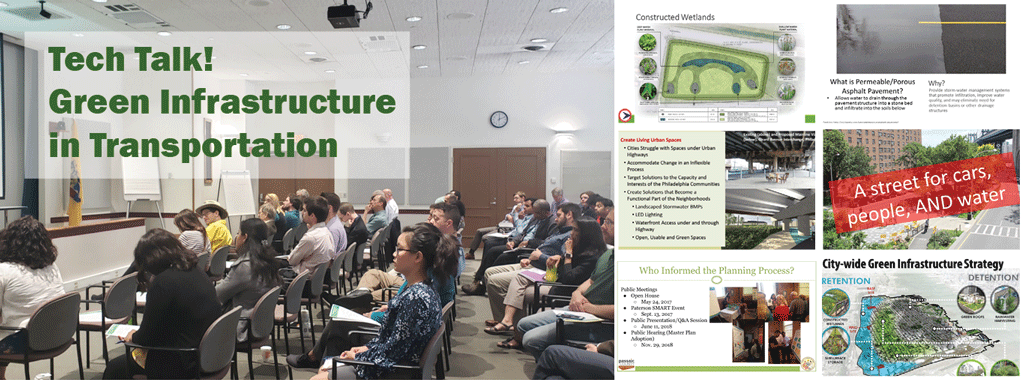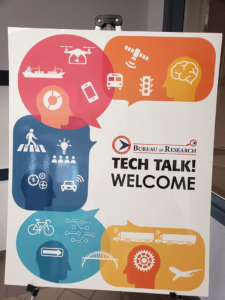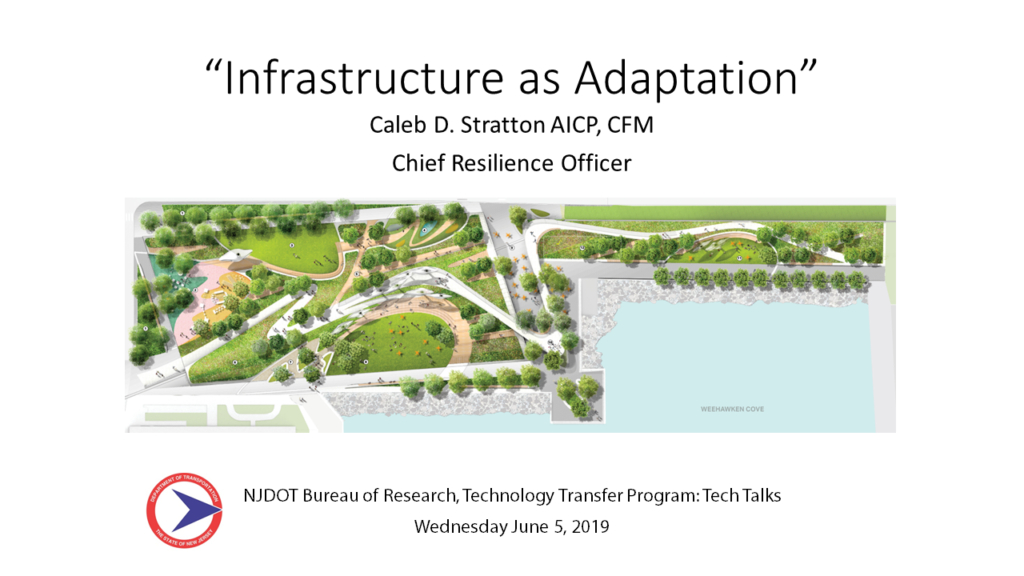The NJDOT Bureau of Research hosted a half-day Tech Talk! Event, Green Infrastructure in Transportation, that highlighted examples of transportation-related green infrastructure projects that have been planned and implemented for stormwater management and flood protection. The event included speakers from state DOTs, county and local governments, the consulting engineering sector and the policy advocacy community. The speakers reflected a multi-disciplinary orientation of engineering, planning and environmental science specializations. Their talks touched upon both planning and project implementation activities at the state and local levels that have been undertaken in response to the increasing intensity and frequency of severe weather events and subsequent flooding. Registration was full for this half-day event held in the NJDOT Multipurpose Room on June 5, 2019.
Representatives of New Jersey, Maine and Pennsylvania Departments of Transportation presented Stormwater Best Management Practices to control and treat highway and parking lot runoff. Local agencies in Passaic County and the City of Hoboken presented their priority strategies and actions for addressing stormwater management through the adoption and implementation of Green Infrastructure Strategic Plans. A representative of New Jersey Future, a statewide non-profit advocacy organization that promotes smart growth policies, discussed opportunities to advance green streets throughout New Jersey.
Sandra Blick, P.E., NJDOT, Bureau of Landscape Architecture and Environmental Solutions. Ms. Blick provided key background definitions for green infrastructure, descriptions of the elements of green infrastructure, and a brief history of green infrastructure in New Jersey related to state standards, testing and design criteria, and proposed NJDEP rule changes. She also discussed NJDOT’s implementation of green infrastructure best management practices over the past decade, including bio-retention basins and swales, constructed wetlands, infiltration basins, and porous sidewalks, among others. Ms. Blick noted that green infrastructure for roadways involves complex design and construction and requires intensive maintenance. She emphasized that these strategies only work if the water treatment processes continue to function.
Brian Luce, P.E., Maine Department of Transportation, Pavement Quality and Design. Mr. Luce described MaineDOT’s experience with installation of porous asphalt pavement on Maine Mall Road and at the International Marine Terminal (IMT) in Portland, Maine. He described the initial design and construction in 2009 of porous asphalt on Maine Mall Road, a relatively high-traffic segment of roadway, and current road conditions. His talk touched upon the success and durability of the project along with some lessons learned in select distressed sections due to sub-optimal temperatures during construction and the tracking of sands and salts onto porous sections that require patching. Mr. Luce noted that the success of the Maine Mall installation gave Maine DOT the confidence that a similar porous pavement structure could work for a chassis yard pavement project at the IMT to filter pollutants in stormwater runoff before it entered a nearby waterbody. After installation, a storm event provided evidence of the pavement’s effectiveness. However, a subsequent review of the IMT revealed some raveling at joints and in isolated areas, most likely due to cold air and base temperatures during construction, as well as cooler mix temperatures due to a long haul to the site. The repair techniques that were subsequently required at the IMT site offered lessons, Mr. Luce observed, potentially applicable to the Maine Mall Road when repair and replacement of porous structures are needed.
Elaine Elbich, P.E., Pennsylvania Department of Transportation and Edwina Lam, P.E., AECOM. In their presentation, “21st Century Stormwater Management: Designing and Building Gray and Green Infrastructure on I-95,” Ms. Elbich and Ms. Lam discussed this highway reconstruction project that slices through Philadelphia along the Delaware River. In addition to designing for stormwater best management practices, they sought to improve waterfront access, lighting, and access to usable green spaces, and described solutions in response to challenges in this urban environment, such as right-of-way, contaminated soils, historic properties, underground utilities, and maintenance. The presenters described the Sustainable Action Committee, formed to coordinate decision-making among agencies and ensure integration of stakeholder and community needs in the design and planning process. Their talk also highlighted the value of an ongoing and productive partnership with Villanova University in providing critical research on the performance of green infrastructure solutions such as rain gardens off an elevated highway as part of their stormwater management solutions. Ms. Lam described the primary stormwater management elements, and the materials and extensive planting involved.
Kandyce Perry, New Jersey Future, Jersey Water Works. Ms. Perry presented on “GREEN and Complete Streets: Designing Streets for People, Cars, AND Stormwater.” She introduced the New Jersey Future’s New Jersey Green Infrastructure Municipal Toolkit and presented several examples of green infrastructure implementation in New Jersey communities, and potential sites for implementation. She noted that the publication, Complete & Green Streets for All, currently being circulated in draft form, provides a model policy and guide for local agencies for planning and implementing Complete Streets that incorporate green street features. Ms. Perry suggested that NJDOT could support green infrastructure by adding green streets into the state’s Complete Streets policies and programs, prioritizing green streets through the Local Aid grant program, partnering with local agencies on demonstration projects, and integrating green streets into the NJDOT Roadway Design Manual.
Jason Miranda, Passaic County Department of Planning & Economic Development. After highlighting the benefits of green infrastructure, Mr. Miranda spoke about the County’s recently undertaken planning process that preceded the adoption of the green stormwater infrastructure element of the Passaic County Master Plan. He discussed the County’s Stormwater Management Guidance Manual and Green Streets Guidelines as key parts of this Master Plan element. Mr. Miranda provided an example of a green streets initiative, the Haledon Avenue Green Streets Pilot Project in the City of Paterson. The County is working on a monitoring plan to evaluate the project and is working with community groups to ensure maintenance. The County has formed a Green Stormwater Infrastructure Committee to identify future projects.
Caleb Stratton, AICP, Chief Resilience Officer, City of Hoboken. In his presentation, “Infrastructure as Adaptation,” Mr. Stratton discussed the storm events that resulted in extensive flooding in Hoboken and propelled the development of a citywide Green Infrastructure Strategic Plan to manage stormwater. He emphasized the importance of leveraging funding for road resurfacing and lighting projects to acquire funding to implement green infrastructure projects and mentioned how Hoboken has effectively worked with the state’s infrastructure bank. Hoboken’s green infrastructure strategy defines green infrastructure techniques that address retention, detention, and infiltration in specific areas of the city. He showed examples of rain gardens, pervious pavement, bio-swales, cisterns, and other infrastructure that have been implemented in the city. This included visualization and photos of green street elements incorporated into street design improvements on First Street and Washington Street to address stormwater. He also referred to the city’s ongoing development of the Hoboken Street Design Guide to guide design and construction of Complete Streets and green streets.
The presenters made several additional points in response to audience questions and comments.
- The market is driving public/private partnerships that support green infrastructure. In Philadelphia, a development corporation is working with PennDOT to make it easier for people to access the waterfront. The agency is also working with various entities in communities along the project corridor.
- It is often difficult to determine which green infrastructure alternatives to use but industry is learning. Speakers agreed that green infrastructure will not be the solution in all situations; these projects must pass the benefit/cost test.
- Green infrastructure installations make extensive use of plant material, at times unsuccessfully due to the effects of contaminants. Research is continuing in order to determine which plants will stand up to the absorption of contaminants, in particular road salts.
- Planners need to be aware of where water is going once it is collected via stormwater management techniques. Speakers cautioned that water cleaned through such a system may migrate to a contaminated zone.
- The speakers noted that green infrastructure is increasingly discussed, but implementation varies depending on the capabilities of the transportation agency or engineering firm. The proposed NJDEP rule changes that require inclusion of green infrastructure in future development projects will lead to broader awareness and implementation through the state.
Resources
Green Infrastructure Municipal Toolkit
Green Infrastructure Element of the Passaic County Master Plan
Hoboken Green Infrastructure Strategic Plan
New Jersey Stormwater Best Management Practices Manual
New Jersey Developers’ Green Infrastructure Guide
Philadelphia Innovates on Green Infrastructure (Click here to watch video)














